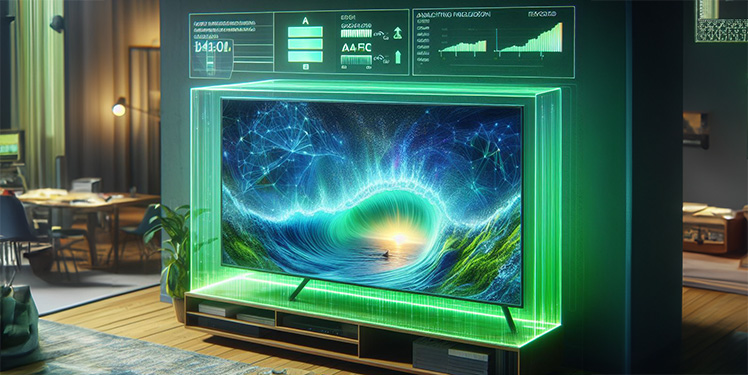In part 2 of our blogpost series, “Decoding Green Streaming” we discussed the analysis of streaming devices’ energy consumption. We focused on exploring how various factors such as content characteristics, stream parameters, and display settings can impact overall energy consumption of Smart TVs and streaming devices. Part 3 addresses how we can leverage the insights gained for a more energy-efficient and sustainable streaming and provides a glimpse into new technologies and solutions that can support green streaming in established streaming workflows. So let’s get into it.
How can we leverage the insights so far?
Based on the initial measurements conducted in the Fraunhofer FOKUS Smart TV-Lab, it has become apparent that the energy consumption of larger devices, particularly Smart TVs, is significantly influenced by the brightness of the display. Two factors come into play: the individual settings of the TV and the brightness of the displayed content. Stream parameters such as resolution, bitrate, or codec, on the other hand, offer only very limited energy-saving potential.
To better understand how a possible reduction in the brightness of streaming content affects the perceived image quality, further analyses are required. In a preliminary attempt, we gradually darkened our reference content, reducing the brightness in percentage steps compared to the original. Brightness is, strictly speaking, a subjective perception of how intense or vivid a visual stimulus appears and can be understood as a psychological interpretation of the physical quantity of light. It is, therefore, a perceived quality without a specific unit. In contrast, the term luminance refers to the amount of light emitted, reflected, or transmitted by a surface per unit area. Luminance is measured in candela per square meter (cd/m²) and is thus an objective measure of the physical quantity of light.
In our considerations, we focused on the brightness reduction of the test content, generated through corresponding re-encodings of the original content and within another experiment we manipulated the resulting content via our FAMIUM GreenView library to display content more energy efficient. Based on these test contents using our reference content ‘timescapes,’ we calculated the resulting VMAF scores and conducted energy consumption measurements during playback. These measurements were repeated for various settings of the OLED Smart TV under test.
We will delve into selected results here, and in further analyses and future blog posts, we will conduct further detailed investigations. In the example of the measured 55″ OLED TV, the graphs predictably show a measurable effect of reducing the brightness of the displayed content. In the example, alongside the original content, the curves for reducing the brightness of the content by -5%, -10%, and -20% are depicted. The corresponding VMAF scores of the individual clips compared to the original are summarized in the table below. As the VMAF score remained relatively constant up to a brightness reduction of 10% (94.7) and in a very high range for our test content, it was selected as a reference for the evaluation. With further brightness reduction, the VMAF values decrease, and a visibly significant difference from the original also becomes apparent in the visual quality of the content.
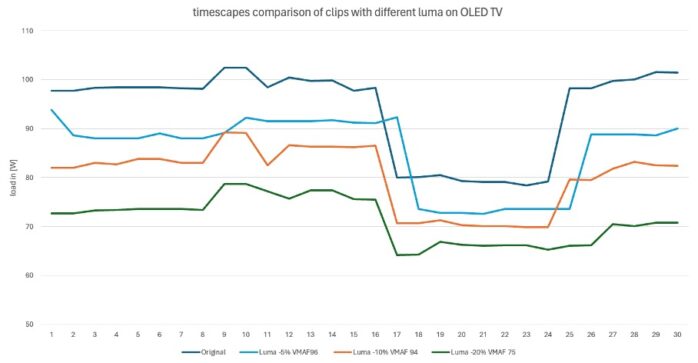
The savings potentials for the playback of the examined content on our 55″ OLED TV are indeed very positive. Even with a brightness reduction of only 5%, there is an energy saving of 9.0% compared to the original. At 10%, the savings increase to 14.6%, while maintaining an acceptable visual result. The observations from the previous measurements are thus confirmed here as well, clearly demonstrating the dependence of the total energy consumption during playback on Smart TVs on the brightness of the content displayed and, at the same time, the relatively high and easily achievable savings potentials.
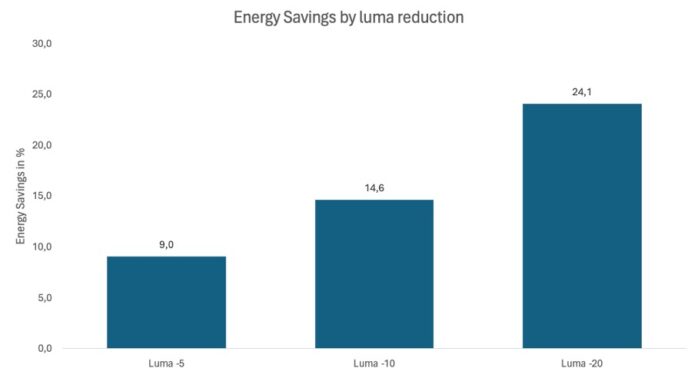

| Test Content | VMAF | Energy Savings | Control Image |
| Original | – | – |  |
| Luma -5% | 95,7 | 9,0% |  |
| Luma -10% | 94,3 | 14,6% |  |
| Luma -20% | 75,0 | 24,1% |  |
FAMIUM GreenView enables green streaming
FAMIUM GreenView, a green streaming solution developed by Fraunhofer FOKUS, enables a more energy-efficient streaming on SmartTVs. Our client-side solution dynamically adjusts the presentation of streaming content for energy-saving playback without modifying the original content.
At its core, FAMIUM GreenView consists of a library seamlessly integrated into the streaming service’s application, along with a backend component providing optimal settings for an individual streaming session. Leveraging context parameters such as content, device, and display type, the FAMIUM Green View AI model delivers individually tailored configurations to optimize streaming session for energy-efficient playback.
The FAMIUM GreenView AI model is trained using datasets derived from our measurements using the FAMIUM Green Streaming Measurement Framework as well as streaming metrics collected through FAMIUM Stream Analytics.
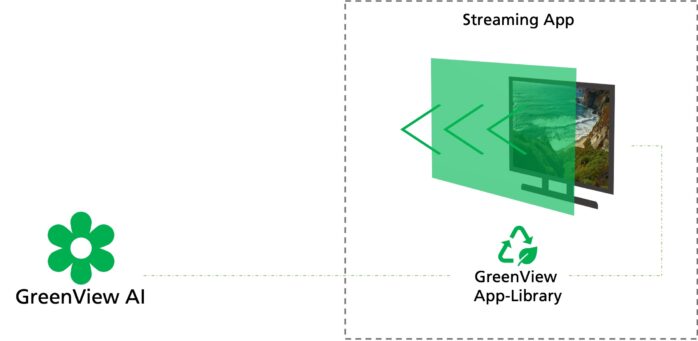
Currently available for Android-based Smart-TVs through Exoplayer and HbbTV, FAMIUM GreenView extends its benefits beyond just OTT and media library content, enabling energy-savings even for traditional linear broadcast TV. With FAMIUM Green View, users can enjoy their favorite content while reducing energy consumption.
We will showcase FAMIUM GreenView at NAB Show 13-17 April 2024 in Las Vegas and at FOKUS Media Web Symposium 11-12 June 2024 in Berlin.
In another series of tests, we measured and analysed the energy consumption of smart TVs during streaming using a FAMIUM GreenView enhanced HbbTV application. The following two figures illustrate the respective power consumptions of an OLED TV for two different 60-second contents, where gradual modifications of the displayed brightness were applied via FAMIUM GreenView. The test contents included the already introduced timescapes clip, as well as a sequence from a typical football (soccer) match.
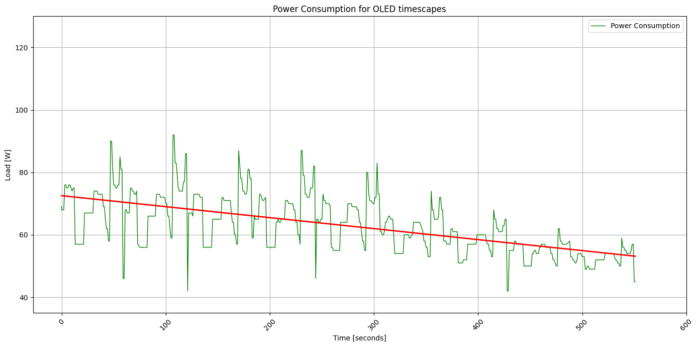
Power Consumption for OLED with FAMIUM GreenView playing timescapes
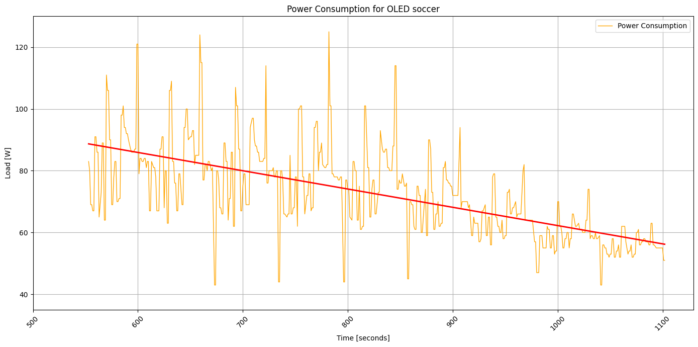
Both diagrams also demonstrate potential energy savings through suitable modification of the displayed resulting brightness. For a thorough analysis, the energy consumption of each sequence for both test contents is presented below. The results show the dependency of energy consumption on the respective test content, as observed in previous tests, thus confirming the approach of FAMIUM GreenView to optimize the applied modifications individually based on the specific device, content, and possibly other contextual variables. At the same time, as noticable in the example of the bar chart of the timescapes test content, it is evident that further measurements and analyses are necessary to generate suitable datasets for optimizing FAMIUM GreenView AI models and to make the approach as universally applicable as possible. The FAMIUM Green Streaming Measurement Framework described in part 1 of the blog post series serves as the basis for this.
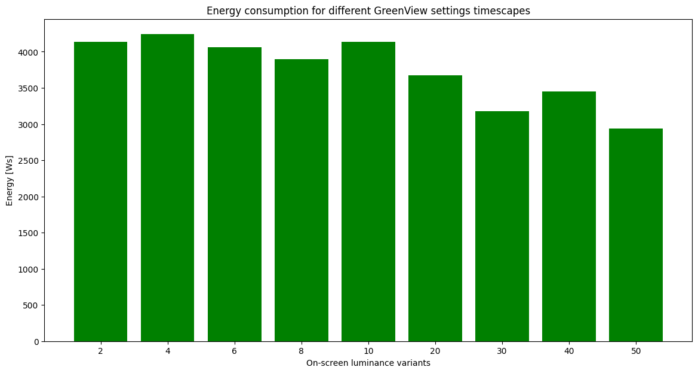
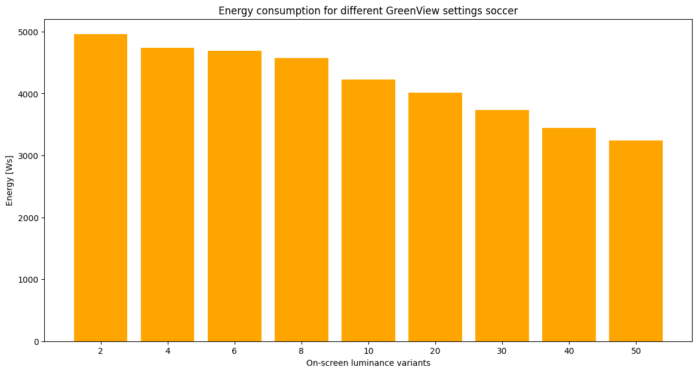
Additionally, we are currently conducting initial qualitative user studies on FAMIUM GreenView. These studies help evaluate the perceived quality of the resulting content and find the best parameters where energy savings are possible without compromising the quality of experience (QoE), or where the ideal trade-off between energy savings and QoE in streaming is achieved.
Summary and Outlook
In our measurements, additional dependencies have already become apparent. The visually perceptible quality of brightness-reduced content depends on the content itself. Meaning that scenes reduced by 10% in brightness may be perceived differently. While there is hardly any noticeable difference in perceived quality for Scene A, it might be noticeable for Scene B under the same parameters. Simultaneously, the potential savings are strongly influenced by the TV’s chosen display and panel settings. For instance, using specific picture modes, we observed differences of up to 40% in power consumption for content with a 10% brightness reduction compared to the original.
We can conclude, that bitrate and resolution in video streaming have a very low, practically almost negligible impact on the energy consumption of smart TVs and other streaming devices. The real energy-saving potentials are hidden in the respective display and device settings, showing a characteristic dependence on the brightness of the content being displayed.
To conduct a deeper analysis, we plan to carry out further measurements, evaluating the dependencies and proportionalities among different end devices, display technologies, device settings, content, and stream parameters. The FOKUS Green Streaming measurement framework, which is currently in development, utilizing the FAMIUM ABR Testbed and FAMIUM Stream Analytics Solution, will serve as the foundation. In future iterations, we aim to measure and analyze additional components of the streaming supply chain, such as AI-driven encoding and distribution networks to verify whether parameters like bitrate, resolution or content specifics may have an measurable and relevant impact on energy consumption of streaming. Based on the analysis results, datasets will be generated for the development and training of AI models, enabling a more holistic modeling of the streaming chain and an examination of its overall energy efficiency.
Curious about our activities in green streaming? Explore green-streaming.de for details, register for our upcoming FOKUS Media Web Symposium and reach out to us!
contributing authors: Robert Seeliger, Minh Nguyen, Martin Lasak, Görkem Güclü, Daniel Silhavy

